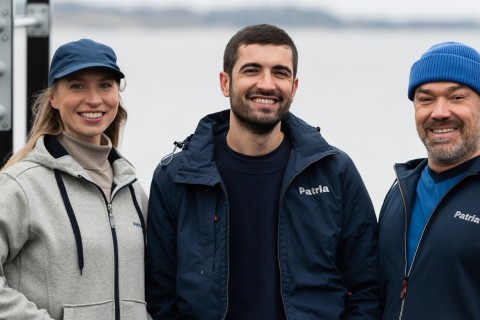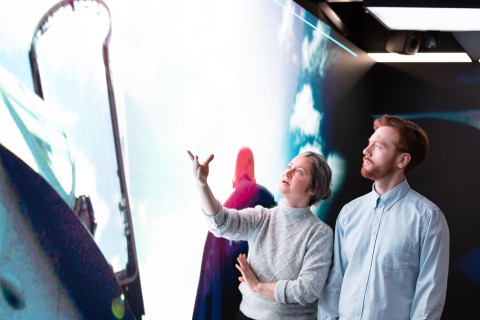
5.12.2017
Patria’s new Pilot Training Centre in Pirkkala brings high-quality training of commercial pilots to a new level. Students’ excellent employment prospects and positive feedback from airlines bear testimony to the results of the work.
Text: Matti Remes
Photos: Matti Immonen
Ville Kettula contentedly gives a tour of the new and shiny premises and aircraft.“In the new training centre, both students and teachers can take advantage of modern techniques and the most recent practices, which meet the requirements set by airlines,” says Kettula. This year, Patria has added four new single-engined Diamond DA40 NG and one twin-engined DA42-VI training aircraft into its fleet. Patria´s new Pirkkala base also received two new flight simulators for the DA42-VI aircraft. “The new fleet provides an unquestionable competitive edge. Many other flight schools use older aircraft and equipment which means that their students need a longer orientation period after they begin work at an airline,” comments Kettula.
Highly appreciated Training Centre
Since 1998, Patria has trained hundreds of professional pilots for civilian aviation. “We have long experience of flight training and over the last few years we have grown into one of the leading training centres in Northern Europe,” Kettula says. Patria Pilot Training has 30 permanent employees in Pirkkala. Most of them are experienced flight instructors. Freelance instructors, most of whom work at airlines, are also used. They bring their special expertise and up-to-date information on the practices and requirements applied in airlines. “Our instructors are experienced aviation professionals. They also have pedagogical skills, enabling them to get their teaching across effectively.”
Kalle Pietilä is an experienced flight instructor and he brings up-to-date information on the practices and requirements applied in airlines.
Experienced instructor reinforces learning
light instructor Mika Nieminen has had a long career in military and civilian aviation. He served in the Finnish Air Force for 20 years as a fighter pilot and flight instructor. After that, he worked as commercial pilot flying to destinations around the world. “Varied experience and perspectives are definitively an advantage in teaching. If you have been involved in a wide range of situations, you can teach students more than they can learn from textbooks,” Nieminen says. Nieminen acts as an instructor on 3–4 training flights a day, during which students can put what they have learned into practice. Learning is efficient when an experienced instructor is sitting next to the student, providing guidance on how to react to sudden changes in weather, or explaining the terminology used in radio traffic, for example.
Mika Nieminen, flight instructor,TRM.
A new type of a training programme
At present, Patria is training five courses with a total of 100 students. The two-year commercial pilot training program comprises of extensive theoretical studies including around one thousand hours and between 200 to 250 flight hours. Alongside traditional commercial pilot training, in collaboration with Finnair Patria has started a new Multi-Crew Pilot Licence (MPL) training programme. MPL combines basic training with full type rating training for the Airbus A320 in a single training program. The training includes both traditional pilot training and modern simulation technologies. “In this way, pilots become familiar with their future workplace during training. When pilots start their work, they need less orientation. A few flight schools are able to offer similar training at the moment,” says Ville Kettula.
Students’ employment is a testimony to the results
In the Multi-Crew Pilot License training both aircraft and, more importantly, modern flight simulation technology is used.
Kettula points out that high-quality pilot training is based on requirements by the aviation authorities for training programmes, equipment, aircraft, premises, teachers and students, among other issues. To become a pilot, an applicant must pass aptitude tests, followed by an aeromedical examination. “Finland is known as a punctual country where things work as they should. Also, Finland’s strong reputation in the educational sector is well known. This is a good start, as Patria intends to increasingly target the international market in the future,” Kettula says. Finland’s variable weather conditions are also a competitive edge in pilot training. During the course, students receive versatile flight experience in conditions ranging from snowfalls to hot weather. “A pilot must be able to act under very varied conditions and to prepare for ever changing weather. Not all flight schools can offer similarly variable conditions as we can in Finland.” Kettula points out that the best metrics for the quality of training are good employment records and positive feedback from airlines. In Kettula’s opinion, continued development of training is important to ensure that it meets all requirements of our customers and aviation regulations alike. “We want to be a credible partner for airlines, even in the years to come as the need for commercial pilots is growing worldwide.”
This year, Patria has added four new single-engined Diamond DA40 NG and one twin-engined DA42-VI training aircraft into its fleet. Additionally, Patria operates 9 Tecnam P2002 JF aircraft (pictured).
What did you like about the article?
Thank you for your opinion! You can share the article on social media using the buttons below:





























